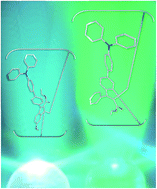In order to obtain new polymeric materials endowed with improved optoelectronic performances, suitable side chain engineering was designed to insert different chromophores showing electron donating ability [i.e. triphenylamine (TPA) and 9-methylcarbazole (MCBZ) residues] in two different key positions (i.e. 6 and 4′) of the 3-phenylindene scaffold of the polybenzofulvene monomeric units. Among the four newly-synthesized polybenzofulvene derivatives, those bearing triphenylamine moieties were found to show higher emissive properties with respect to the corresponding carbazole derivatives. Moreover, the preliminary OLED devices prepared with the triphenylamine-based polymers showed promising features, but the role of the aggregation process in affecting the emission properties of poly-6-TPA-BF3k suggested that extensive device development studies are required in order to maximize polybenzofulvene performances in OLED applications.

